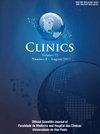Virtual reality and traditional training in surgical instrumentation: A non-inferiority comparative study
IF 2.2
4区 医学
Q2 MEDICINE, GENERAL & INTERNAL
引用次数: 0
Abstract
Objective
Medical education is undergoing a profound transformation due to technological advancements. Integrating cutting-edge tools like virtual environments and computer-based simulators heralds a new era in teaching methodologies. The objective of the study is to analyze the performance and satisfaction levels of residents undergoing basic surgical skills training using virtual reality.
Methods
The authors recruited residents from the first year in general surgery and allocated them randomly into three groups: a) Text; b) Practice and c) Virtual reality. Initially, the residents completed a pretest for an evaluation and then they were trained according to the group they were assigned to. All the residents performed a 30-minute training session. After that, they took a posttest. Both tests were composed of multiple-choice ten questions. At the end of this study, the authors determined the score by calculating the delta of the performance (Δ = posttest –pretest). After the training, all the participants filled in a five-question satisfaction questionnaire.
Results
Regarding the difference between the pretest and post-test, there was no difference between groups. Only one participant (1/8) showed nausea in the virtual groups. The recommendation and satisfaction after the task were higher in the Virtual reality group compared to the Text group. There was an association between satisfaction after the exercises (VR) and recommendation score.
Conclusions
Virtual reality is safe and non-inferior to traditional surgical instrumentation training. This tool might be a practical and attractive alternative to the traditional instrumentation classes.
虚拟现实与传统手术器械训练:一项非劣效性比较研究
目的随着技术的进步,医学教育正在经历一场深刻的变革。整合尖端工具,如虚拟环境和基于计算机的模拟器,预示着教学方法的新时代。本研究的目的是分析使用虚拟现实技术进行外科基本技能培训的住院医师的表现和满意度。方法招募普通外科一年级住院医师,随机分为三组:a)文本组;b)实践和c)虚拟现实。最初,住院医生完成了一项评估前测试,然后根据他们被分配到的小组对他们进行了培训。所有住院医生都进行了30分钟的培训。之后,他们进行了后测。两项测试都由10道选择题组成。在本研究结束时,作者通过计算表现的增量来确定分数(Δ =后测-前测)。培训结束后,所有参与者都填写了一份包含五个问题的满意度问卷。结果前测与后测的差异,组间无差异。在虚拟组中,只有一个参与者(1/8)表现出恶心。与文本组相比,虚拟现实组的推荐率和任务后满意度更高。练习后满意度(VR)与推荐评分之间存在关联。结论虚拟现实技术与传统的手术器械培训相比,具有安全、不逊色的特点。这个工具可能是传统仪器类的一个实用且有吸引力的替代品。
本文章由计算机程序翻译,如有差异,请以英文原文为准。
求助全文
约1分钟内获得全文
求助全文
来源期刊

Clinics
医学-医学:内科
CiteScore
4.10
自引率
3.70%
发文量
129
审稿时长
52 days
期刊介绍:
CLINICS is an electronic journal that publishes peer-reviewed articles in continuous flow, of interest to clinicians and researchers in the medical sciences. CLINICS complies with the policies of funding agencies which request or require deposition of the published articles that they fund into publicly available databases. CLINICS supports the position of the International Committee of Medical Journal Editors (ICMJE) on trial registration.
 求助内容:
求助内容: 应助结果提醒方式:
应助结果提醒方式:


